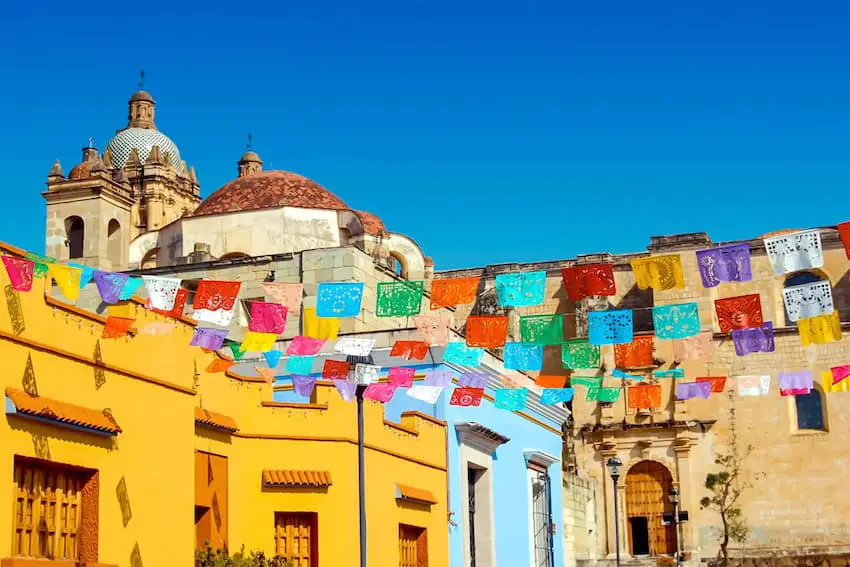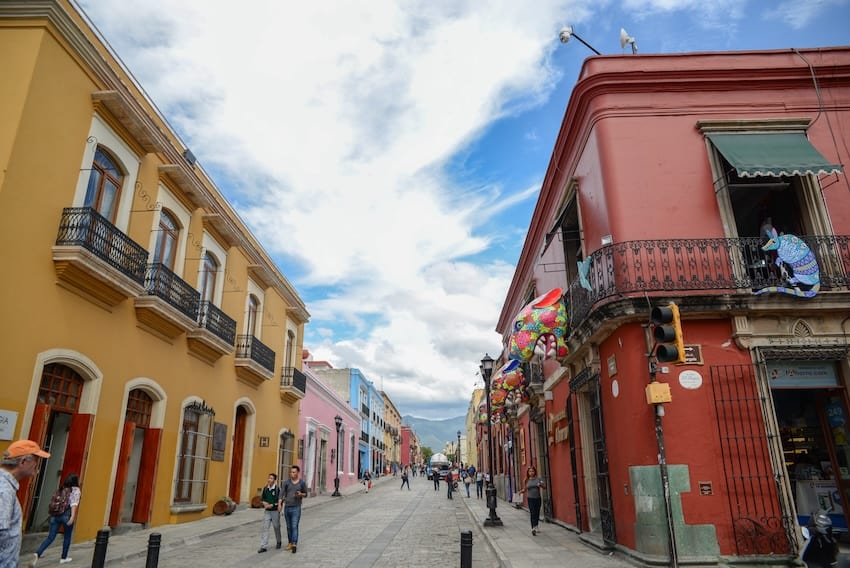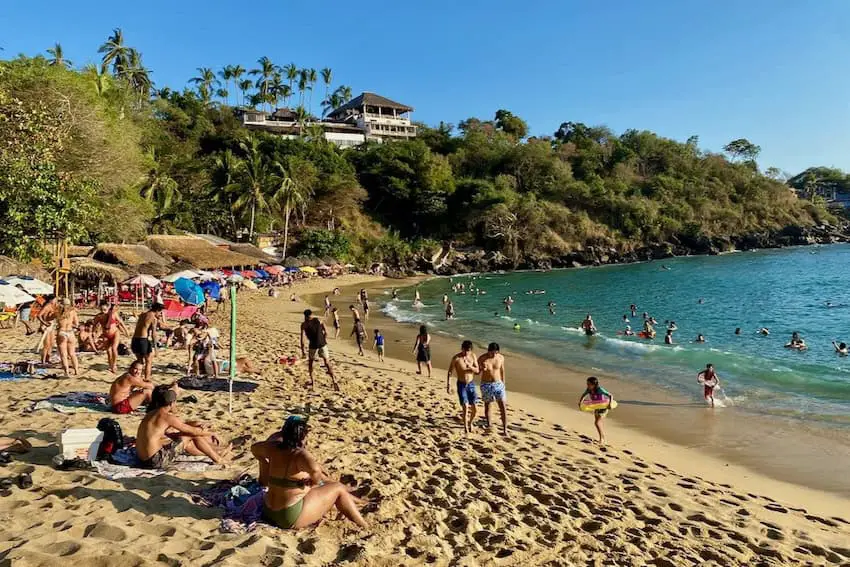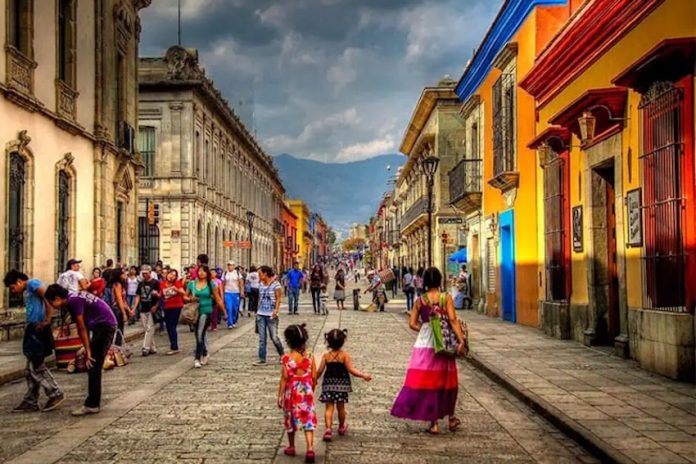Of many factors in your Mexico living deliberations, “authenticity” might not be on the list. It’s not even part of this rating system. Your attention is likely focused on more pressing concerns (medical care, connectivity, climate — all parts of a place’s rating). But when it comes to your new home and “How will you spend your time and find meaning?”, authenticity and a “sense of place” can (for some) percolate to the top of your ponderings.
Oaxaca State will challenge your cultural curiosity in ways that can awaken a deep desire to become part of a land of cultural and biological diversity unchallenged across the continent. Located in Southwestern Mexico with a long Pacific seacoast, towering cloud forests, and a central valley wellspring of human culture, Oaxaca exhibits and celebrates personal discovery at an elevated level. Once a part of the “fertile crescent” of the Americas, one of six places on our planet where human culture first emerged, Oaxaca’s quilt-like cultural patrimony attracts seekers of genuine authenticity from around the world.

Oaxaca is also the state of Mexico with the greatest biodiversity. Seven of the nine ecological zones found in Mexico are on display here. Oaxaca State is home to species that represent approximately 50% of Mexico’s total. One forest (the Sierra Norte) is called the “richest and most varied on earth” by the World Wildlife Fund.
Home to a third of Mexico’s total indigenous population, over a third of Oaxaquenos speak an indigenous language such as Zapoteco, Mixteco, Chatino, Trique, and Mixe. Oaxaca is home to five language families, 15 language groups, and 176 linguistic variants. Mexico’s most authentic Indigenous traditions are manifest by traditional dress, cuisine, festivities, religious beliefs, and social protocols.
By the time the Spaniards arrived in the 1520s, the valley’s inhabitants had split into hundreds of independent village-states that still dot its hillsides and valleys. Some villages trace their ancestry to 8,000 B.C., giving Oaxaca one of the world’s longest, uninterrupted cultural patrimonies. This fact and the state’s varied topography established a tradition of community fragmentation that survives today. Of Mexico’s 2,454 municipalities, 570 are in Oaxaca. Some 400 of these are self-governed and are mostly autonomous from state and federal law.
This cultural patrimony comes, however, with some graphic examples of grinding poverty. Oaxaca is one of the three poorest states in Mexico, along with neighboring Guerrero and Chiapas. In 2023 Oaxaca’s economy grew 8.3% (the second highest figure in Mexico), an outcome of the federal government’s focus on southern Mexico poverty abatement and massive public infrastructure investment. Billions of dollars have anchored infrastructure (the Interoceanic Corridor of the Isthmus and the new highway between Oaxaca City and the state’s Pacific coast) and dispersed direct cash payments to marginalized citizens. However, poverty remains a daily reality for millions of Oaxacans.
Oaxaca city

Sitting at 5,100 feet and residing at the convergence of three mountain-encircled valleys along the Atoyoc River is the magical Oaxaca city — a UNESCO World Heritage Site. Despite its population of 259,000, Oaxaca city somehow feels more like a town than the sprawling city that it is. The grid-like colonial heart of the city is a visual treat.
The pace is relaxed, the atmosphere unpretentious, yet peppered with sophistication in the form of fine dining, galleries and shops. Its downtown streets are lined with exquisite baroque colonial architecture dating from the 16th century, with some also a hotbed for startling modern street art. A unique ethno-botanical Garden, notable museums, the Oaxaca Lending Library (OLL, founded in the 1960s), and a leading Graphic Arts Institute (IAGO) all attract multicultural audiences. The OLL is the mothership for many expats and offers English and Spanish books, a rich calendar of talks, local tours, and volunteer opportunities. The art gallery scene is eclectic and international in scope, with new exhibitions opening weekly.
Reminders of the region’s rich ethnology are visible in the area’s traditional markets, street food, artisan villages, and unique festivals and celebrations. Oaxaca city’s main market (the sprawling Central de Abasto) is to the west of town, near the bus station. This outdoor Saturday market is an enormous feast for the senses — encompassing a massive maze of stalls selling every imaginable product. Near the central plaza downtown are three more interesting markets: Mercado Benito Juárez, Mercado 20 de Noviembre, and the whimsical Mercado de Artesanías.
Not surprisingly, the folk art tradition of Oaxaca is unsurpassed in Mexico. Part of living here embraces the region’s fascinating artisan villages. Within a 50-kilometer radius of Oaxaca City are dozens of small towns, many of which specialize in a particular art or craft tradition. Oaxaca is also recognized globally for its vibrant, inventive, and diverse cuisine (including a 2024 Michelin Star) and its signature distilled spirit mezcal. Most local restaurants and trendy cafes produce some variety of rich moles (complex sauces created with nuts, spices, and even chocolate) for which the region is famous.

Okay, but what’s it like to live here? In a country of superlatives, Oaxaca can seem to top them all. This does, however, come with some notable trade-offs when it comes to daily living. English speakers can be harder to find than in Mexico’s coastal resorts. One local expat discloses how the year-round foreign-born population is small, growing notably during winter months. Europeans love Oaxaca for visitation and can outnumber Americans and Canadians in some social settings. Expats are scattered across the city, and connecting will take some effort. Two of the more iconic neighborhoods for home purchase/rentals are Jalatlaco to the east and Xochimilco to the north.
One Facebook contributor recounts the challenges of life in Oaxaca. “It takes grit to live here; many leave after 12 months,” they said. “Water issues, strikes and road closures, earthquakes, and lifestyle (slower paced, focusing on community and family) can break the less resilient.” There can be challenges when it comes to advanced medical care, the climate is hotter and more humid than in more northern locations, and air connectivity is limited to mostly connecting via CDMX (with some exceptions). There is no Costco in this ancient land, and box stores are limited. It’s Mexico living where you’ll need to be flexible, learn some Spanish, and take life (the gritty and the gentrified) as it comes.
The Oaxaca Coast

If you plan to frequent the coast (or live seasonally), Oaxaca state can be an ideal option. The new super highway opened in February and is a game-changer for the state. The toll road is free until September 2024 and has obliterated the drive time from Oaxaca City to Puerto Escondido, down fromseven hours to under three. Two poles of development are Puerto Escondido and Huatulco – worlds apart in setting and beach resort vibe. One hundred fifteen kilometers separate the two and there’s a regular bus service between them.
Puerto Escondido is (still) barefoot bohemian, surfer-friendly, and has largely rejected beach resort conformity found at many coastal locations in Mexico. The all-inclusive resort model is not the norm. International and Mexican artists and architects building avant-garde boutique hotels and homes leave their lasting impact at places like Casa Wabi. Huatulco, by contrast, has mega-resort aspirations never realized, a less flashy cousin of planned resorts like Ixtapa and Cancun that never caught on. It’s a comfortable, model interpretation of what a resort conceived in the 1980s might have become and has substantial sustainable tourism development regulations, nine bays, and modern infrastructure.
Living on the Oaxaca coast comes with significant trade-offs, as highlighted in our rating. Huatulco is better for families, while Puerto has more diverse dining, nightlife and a surfer/digital nomad temperament. However, both places are uniquely Oaxacan, as are the coastal communities (Puerto Angel, Zipolite, Mazunte) connecting the two. If isolation and authenticity are your callings, the often-romanticized classic Mexican Pacific fishing pueblo is found along Oaxaca’s south-facing beaches and village settings.
Choosing to live in Oaxaca is something you’ll never regret. And it might just change your life.
The ratings
![]()
What did we get right? What do you disagree with? Let us know in the comments.
You can see more of our Where to Live in Mexico 2024 series here.
Author Greg Custer lives in Mexico. He’s worked for over 40 years in international tourism, educating travel advisors around the world about Mexico and other Latin American destinations. He helps folks explore Mexico for living at www.mexicoforliving.com.
